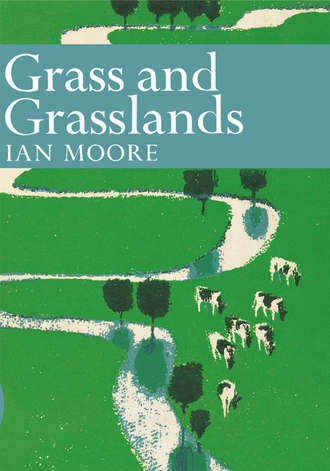
Полная версия
Grass and Grassland
A number of other grasses are on the other hand very specialised in their habitats. Moor mat grass is usually associated with the margins of peat moors, not because it will not grow elsewhere, but because it grows better under such conditions than any other. A number of grasses can endure strong salt water, such as marram grass (Ammophila arenaria), the salt marsh grasses (Puccinellia spp.), and sea lyme grass (Elymus arenarius), and these are confined to our coasts. Marram and sea lyme are used for stabilising wind-blown sand, while the salt marsh grasses and rice grass (Spartina townsendii) are mudbinding plants of salt marshes.
Other grasses adapt themselves well to a high water content in the soil, and “water meadows,” where periodic and controlled flooding was carried out, were in use until quite recent times. To a limited extent this is still practised in Wiltshire and Dorset. The operative phrase is “controlled flooding” for good drainage of the soil is imperative for the growth of the best types of grasses useful to the farmer. Under waterlogged conditions the deficiency of an adequate air supply to the plant roots spells failure for the ryegrasses, cocksfoot, timothy, rough stalked meadow grass, and similar productive species. Under such conditions tussock grass (Deschampsia caespitosa), rushes (Juncus spp.) and sedges (Carex spp.), which are inedible for livestock, become dominant.
The true seed of grasses is not normally seen, since the fruit-coat is very thin and firmly attached to the single seed. This type of fruit is known as a caryopsis: a wheat grain is a good example. Most grass “seeds” consist of a single grain tightly enclosed within the lemma and palea; attached to the base is generally a small portion of the axis of the spikelet. In the case of Yorkshire fog, meadow foxtail, and a number of other grasses the “seed” is, however, an entire spikelet and consists of the two glumes, and the lemma, palea and grain of one or more flowers, while in the case of the brown “seed” of timothy and most wheats the grain is shed free from its lemma and palea. The bulk of timothy seed, however, is the silver grey “seed” composed of the caryopsis complete with lemma and palea. These examples illustrate how the grass “seed”—that part of the plant which is actually sown either naturally or in agricultural practice—differs from the true seed.
Grasses are distributed in the main by the wind, for the caryopses with their enclosing glumes are light and capable of being carried long distances. Some seeds are plumed, others possess tufts of hairs which doubtless increase their buoyancy. Gales and whirlwinds are likely to exert a great influence in conveying seeds from one place to another. In Lincolnshire, for instance, a whirlwind has been known to tear up a tuft of couch grass by the roots and carry it for over twenty miles, and it has been suggested that since gale force winds are common during the period July to September, when many grasses are seeding, they must be a very important means of dispersal and probably of greater influence than normal wind-drift.
One must not overlook the influence of water in carrying grass seeds long distances. Their buoyancy in the air is equalled in many cases by their facility in floating on water, while the upper peduncles act as sails to assist them in their passage across estuaries and round coasts. In addition too, it is not unknown for whole plants to be transported by the sea and it is recorded that the sugar cane on Cocos Keeling Island was derived from a clump from Java, seven hundred miles away. Bamboos have also been known to be moved from place to place. Drifting rhizomes in rivers and in the sea also bring about dispersal and in Europe, Puccinellia maritima, Elymus arenarius and Ammophila arenaria are known to be dispersed by these means. Tufts of annual meadow grass are often carried long distances by rivers and indeed, of all grasses this is perhaps the most determined to establish itself by some means or another. At Seale Hayne it is regularly removed from the roof gutters and spoutings thirty feet above ground level. It springs up between cobblestones and flags in the heart of our largest industrial cities and I have found it growing in birds’ nests in late autumn after the nests have been abandoned and are well soaked with rain. This is particularly the case in thrushes’ nests which are mud-lined. It has also been found 12,000 feet up in the Himalayas where it was concluded that man or his yak must have been the means of conveyance. The glumes of some grasses bear stiff reflexed spines which help the seeds to cling to clothing, to the wool or fur of animals, or to the feathers of birds. In the Belgian Congo termites store large quantities of a species of Cynodon in their nests and when these are abandoned the grass is established. I heard of a most interesting case when in New Zealand, where man quite unwittingly was the means of introducing red-top. Emigrants before leaving Nova Scotia filled their mattresses with hay which included red-top. They travelled to the Cape of Good Hope, thence to Australia, and finally settled in New Zealand where the mattresses were abandoned; the grass seeds germinated and thus an American grass became established in a strange country!
The farmer classifies a grass as useful or useless according to its particular value to him. There are over a hundred and fifty different species of British grasses but of these no more than twenty are of real agricultural value and indeed, on the majority of farms, considerably fewer are regarded as of consequence.
The value of grass to the farmer depends upon (a) productivity, or yield, (b) feeding value or chemical composition, (c) palatability, (d) persistency, (e) winter greenness and (f) earliness. To the groundsman, however, it is obvious that such factors as (a) slowness of growth, and (b) wearing capacity and ability to recover from harsh treatment, are of much more importance, while the landscape gardener must also look for very different qualities in grasses to form ornamental lawns or for foliage work in border and greenhouse. Quite naturally, in the case of both groundsman and gardener, the species used are often different from those used in agriculture, and in these pages I have concentrated on the latter.
The yield of herbage produced by any grass, which is the farmer’s first consideration in making a selection, depends upon its tillering capacity, the facility with which it recovers from cutting or grazing, and the duration of growth each season. An excellent illustration is obtained by comparing perennial ryegrass and bent grass. The former tillers freely and grows steadily from early spring until late in the autumn and indeed, in the mild wet south-west of England it grows all the year round. In contrast to this, bent grass grows for a short period only and yields comparatively little bulk, and in consequence is discarded by the farmer as being of no value. To him it is in fact a weed.
Then the ability of a grass to recover from cutting or grazing is also of great importance, defoliation being more favourable to the development of young tillers in some species than in others. Recent work has tended to stress the importance of the influence of intensity of defoliation on the yielding capacity of grasses. It appears that by leaving some growth—say one to two inches—when cutting or grazing a sward, more rapid recovery of growth follows, and hence more bulk or weight of grass over the whole season is obtained, than when animals are allowed to graze tightly to the ground or the mowing machine blades are set as closely as possible to the bare earth. The full answer is not yet known, for species vary in this respect and are also subject to seasonal variations.
While most grasses are palatable if eaten in the early stages of growth, quite a number develop harsh or hairy leaves, or even spines on the leaf margins, as they grow older, and hence are rejected by stock. A grass which may be highly valuable in all other respects can be rendered useless by this factor; Yorkshire fog and the coarser forms of tall fescue are typical examples. In practice it is not always possible to utilise a field at the ideal stage of growth, when the grass is most palatable to stock, and thus grasses which retain their palatability over a long period are particularly valuable. Yield and feeding value are complementary factors, the one without the other being useless to the farmer. In this connection the structure of the grass is important, for species with a high proportion of leaf to stem are much more valuable than stemmy ones, since the leaves are more palatable and contain more protein than the stalks. Grasses become coarse and stemmy with a corresponding reduction in feeding value as they reach the seeding stage. Plant breeders of recent years have endeavoured, therefore, to produce strains of grasses with a high proportion of leaf to stem and with a natural reluctance to produce flowering heads.
From the farming angle as well as the ornamental, a capacity to remain green during the winter months is important. This extends the grazing season and reduces the need for expensive artificial feeding of livestock. Certain varieties of meadow foxtail and red fescue, for instance, have been bred to produce leafage during February and March.
In the last thirty years a great deal of attention has been paid to variations of type within each grass species. Perennial ryegrass, for example, may be tufted, stemmy and short-lived or it may be leafy and persistent. Some types are very prostrate in growth whilst others are erect. Some are very palatable, others less so. The same comments are applicable to all the important species of commercial value such as cocksfoot, timothy, and meadow fescue, and these are classified into what are technically known as “cultivars” (but more familiarly as varieties or strains), and multiplication by division and seed of these strains is carried out on a large scale.
It is very evident there can be no simple answer to the question, “Which is the best grass?” Quite apart from the great variations which we have seen exist within the grasses themselves, the complexity of the problem is magnified by varying systems of management whether for grazing or conservation, by the use of different seeds mixtures, by fertiliser and herbicidal treatment, by disease and insect pest, and by the varying requirements of sheep and cattle. The whole fascinating study is unfolded in the following chapters.
CHAPTER 4 TYPES OF BRITISH GRASSLAND

Centuries of biotic influence have brought about the formation of our so-called natural types of grassland, for even the wild stretches of hill and moorland, which to most people epitomise natural grassland, owe their existence to the influence of countless generations of grazing animals, particularly sheep. Without man’s influence heather, bracken, and scrubby growth soon colonise the land to act as the forerunners of bush, pine and rowan until a dense forest growth occupies the countryside. Let us, therefore, be precise and speak of uncultivated and cultivated grassland. The former group includes moors, downs, wolds, heaths and fens, broadly termed rough grazings, while the latter includes the rich permanent pastures and meadows which are “cultivated” by regular mechanical treatment with harrows and rollers and receive periodic applications of the essential plant nutrients though the turf is left undisturbed. Included in this group is the ley or short duration grassland which is ploughed periodically. The subdivisions are clearly seen in table 4:
TABLE 4. SUBDIVISIONS OF GRASSLAND
Uncultivated grassland Cultivated grassland moors: (north and west of Britain) permanent temporary downs: (south and east) pastures leys heaths: (south and east) and of fens: (mainly in the east) meadows varying durationThe transition from ley to permanent pasture or meadows, thence to rough grazing and scrub, and finally to forest, is an orderly, gradual process, the different phases being clearly recognisable yet merging one with another. The great areas of rough grazings are known to all countrymen and townsmen alike and a brief outline of the different types of grassland in this group will give added interest to the countryside.
The soil of our moorland areas, including those of Scotland and the Lake District, the Pennines, the Yorkshire moors of the north-east, the Welsh mountains, and the moors of Cornwall, Devon and Somerset, is acid or “sour” and a marked lime shortage is invariably associated with a deficiency in phosphate and potash. Under such conditions our useful grasses and clovers cannot survive and the flora is very restricted and specialised, the degree of acidity, the rainfall and the drainage determining the specific type of herbage found in any particular stretch of moor. Free-draining land is often in close proximity to bog, but in the majority of cases the sterile condition of the soil has resulted in an accumulation of undecomposed vegetation, “mat,” near the surface and the grassland is said to be “matted.”
On the wetter soils the dominant species is often flying bent (Molinia), the long straws of which were once used by country people for making stiff carpet brushes. Should the peat be waterlogged then cotton grass, deer grass, heath or square-stemmed rush will be found in varying amounts. If the peat is well drained, as on hill sides and knolls, the soil still being very acid, then the dominant grass is matgrass, so named because it grows in dense matted tufts, the hard bristle-like wiry leaves being much too tough for cattle or sheep to eat. Often associated with matgrass will be sheep’s fescue, bilberry and heather. On really deep soil, which is fundamentally good land, bracken is frequently dominant, and when this land is cultivated it yields excellent crops of potatoes and oats. So runs the old adage, “Copper under Heather, Silver under Gorse, Gold under Bracken,” which proved so true in the wartime ploughing-up campaign of 1939–45. Heather land yielded poor crops, even with generous fertiliser treatment, for the soil was too hungry and lacked body, whereas surprisingly good crops followed the ploughing in of bracken. Gorse land gave results somewhere between the heather and the bracken.
Heather moor is primarily sheep country and normally carries about one ewe to four or five acres. Hardy cattle, such as the Galloway, may sometimes be seen in association with sheep on the best moors. The periodic burning of the heather prevents the development of scrub and encourages new growth and, in late winter especially, young heather shoots are valuable in providing adequate sustenance for the sheep. When the burning is too slow, i.e. the fire does not sweep rapidly over the heather and the roots are damaged in consequence, bilberry frequently replaces the heather which represents the next phase in the succession.
The most valuable of the moorland or hill pastures contain sheep’s fescue, red fescue and bent as the dominant species and although these grasses are at the bottom of the nutritional scale as we shall see, they have the advantage of demanding the minimum of attention from the farmer in order to keep a stable sward. Bracken is generally the most serious intruder but this can be kept in check with regular attention. On the moors of Cornwall and Devon rough uncultivated pastures contain Agrostis setacea
Конец ознакомительного фрагмента.
Текст предоставлен ООО «ЛитРес».
Прочитайте эту книгу целиком, купив полную легальную версию на ЛитРес.
Безопасно оплатить книгу можно банковской картой Visa, MasterCard, Maestro, со счета мобильного телефона, с платежного терминала, в салоне МТС или Связной, через PayPal, WebMoney, Яндекс.Деньги, QIWI Кошелек, бонусными картами или другим удобным Вам способом.









